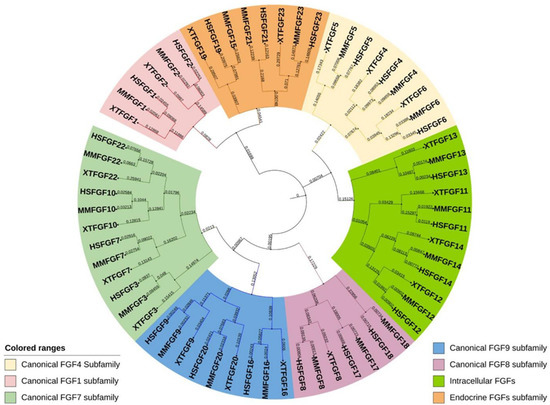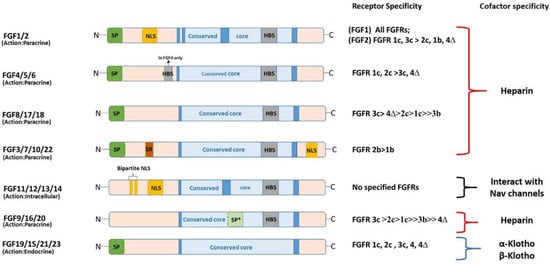The four major signaling pathways activated by canonical FGFs include the RAS-MAPK, phosphatidylinositol-4,5-bisphosphate 3-kinase-AKT, phospholipase Cγ/protein kinase C, and signal transducer and activator (STAT) pathways
[10]. Additionally, canonical FGFs are key regulators of mesenchymal and epithelial signaling required for organogenesis
[26][31].
After binding FGFR, FGF1 crosses the plasma membrane, passes through the cytosol, and reaches the nucleus
[27][28][32,33]. Notably, FGF1 is the only FGF that can activate all splice variants of FGFR
[10], and nuclear FGF1 possibly controls the cell cycle, cell differentiation, survival, and apoptosis
[29][30][34,35].
Phylogenically, the FGF7 subfamily includes FGF3, FGF7, FGF10, and FGF22
[13]. However, some controversies exist regarding the inclusion of FGF3 in this subfamily, as chromosomal synteny supports its inclusion in the FGF4 subfamily
[1]. Notably, a recent study has proposed a new subfamily of FGF3
[31][41]. All members of the FGF7 subfamily selectively activate splice variant IIIb of FGFR2; besides this function, FGF3 and FGF10 activate the IIIb variant of FGFR1
[32][33][39,40].
4. FGF Signaling in Early Development
4.1. FGF and Mesoderm Specification
Earlier investigations in the 1990s on Xenopus and other vertebrate models showed that FGF signaling is necessary for the formation of the axial (which later forms the notochord) and paraxial mesoderms (which develops into the axial skeleton, muscles, and dermis)
[34][35][60,64]. Inhibiting FGF signaling by expressing a dominant negative form of the FGF receptor (Dn-FGFR) disrupts the notochord and somites
[34][35][36][60,64,65]. It is unclear whether FGF functions during the induction of axial and paraxial mesoderm or it is required for the maintenance of these mesodermal subtypes. Fletcher and Harland
[36][65] reported this dilemma in 2008, when they showed in their investigation that the induction of the paraxial mesoderm requires FGF, and axial mesoderm only requires FGF for maintenance during gastrulation. The FGF requirement for notochord development is evolutionarily conserved in vertebrates
[37][66].
4.2. FGF and Neural Specification
The spinal cord cells in vertebrates are derived from neuromesodermal progenitors (NMP) with neural and mesodermal features
[38][39][73,74]. Events of spinal cord development constitute complex processes, such as neurogenesis, ventral patterning, neural crest specification, and migration, governed by the elongation of the caudal axis
[40][75]. Additionally, spinal cord specification involves the FGF signaling pathway as a key regulator. During chicken spinal cord specification, FGF3, FGF4, FGF8, FGF13, and FGF18 are expressed in the caudal NMP region and tissues surrounding the NMPs
[41][42][76,77]. FGF8 and FGF4 expression in the NMP region is sustained for several days, and then declines during the last stage of somitogenesis and the cessation of axis elongation
[40][75].
FGF/Ras/Mapk/Ets initiate neural induction in ascidians, which are the last common ancestor of vertebrates in chordate evolution
[43][44][72,81]. Studies in Xenopus embryos have set the foundation for the classical model (default model) of neural induction, which suggests that signals from the organizer instruct the ectoderm towards neural fate
[45][82]. However multiple investigations in chick embryos have established that FGF signaling is vital in early neural differentiation, challenging the default model idea
[46][47][83,84]. FGF signaling in neuronal specification can be projected in two ways: first, as an instructive signaling where FGF activates neural genes; second, as antagonist signaling where FGF inhibits BMP signaling via smad1 phosphorylation
[12].
4.3. FGF Signaling in Metabolism and Diseases (Cancer)
FGF signaling plays a part in the development of almost every organ (including the heart, lungs, brain, urinary system, muscle, skeleton, and skin) and processes such as angiogenesis and lymphangiogenesis
[6]. Moreover, endocrine FGFs are functionally essential for metabolism and regulate the brain, kidney, liver, and adipose tissues. The dysregulation of FGF signaling leads to various genetic disorders, including cancer, chronic obstructive pulmonary disease, and chronic kidney disease.
4.3.1. FGF Signaling in Metabolism
FGF15/19, FGF21, and FGF23, which belong to the FGF19 subfamily, are endocrine hormones that regulate bile acid, fatty acid, glucose, and mineral metabolisms. Moreover, FGF19 in humans and its ortholog FGF15 are gut-derived circulating hormones that suppress hepatic bile acid via FGFR4 and the cofactor KLB complex
[6]. Additionally, FGF15/19 negatively regulates bile acid synthesis and FGF15 deletion in mice upregulates bile acid synthesis by inducing the expression of the rate-limiting and regulating enzyme cholesterol 7α-hydroxylase (CYP7A1) in the liver
[48][104]. However, FGF15 overexpression restricts bile acid synthesis by downregulating CYP7A1 mRNA levels
[48][104].
FGF15/19 suppresses liver fat storage; in one study, FGF19 transgenic mice showed low levels of lipogenic enzymes and liver triglycerides
[49][107]. Moreover, FGF19 blocks lipogenic enzyme expression in rat hepatocytes by inducing STAT3 signaling and suppressing peroxisome proliferator-activated receptor-γ coactivator-1β expression
[50][108].
FGF21 is a hormone that regulates glucose and lipid homeostasis and insulin sensitivity. FGF21 functions by binding to FGFR1c and its co-receptor protein KLB in the liver, brain, and adipose tissues
[51][116]. FGF21 overexpression in mice resists diet-induced obesity
[52][117], and FGF21 can affect weight loss, reduce plasma glucose and triglyceride levels, and boost insulin sensitivity in obese and diabetic vertebrate models without altering the calorie intake
[52][53][117,118]. The subcutaneous administration of the FGF21 variant (LY2405319) in DIO mice decreased plasma glucose and body weight at a potency comparable to that of FGF21
[54][119].
FGF23 is a regulator of phosphate metabolism and is produced mainly by the osteoblasts and osteocytes of bone tissue
[55][121]. Additionally, FGF23 regulates phosphate and vitamin D homeostasis in skeletal tissues
[56][122], and its mutations lead to low serum phosphorus levels, rickets, bone pain, osteomalacia, and short stature
[57][123]. Moreover, FGF23 overexpression in whole mouse, and mouse liver and osteoblasts, results in a low serum phosphate concentration and rachitic bone
[58][59][60][124,125,126].
4.3.2. FGF Signaling in Various Types of Cancer
FGFs are associated with the initiation and progression of cancers, such as multiple myeloma, urothelial carcinoma, hepatocellular carcinoma, and prostate cancer. The FGF1 expression level in several cancer types, such as breast cancer, hepatocellular carcinoma, and esophageal cancer, shows that growth factors promote tumor cell invasion and metastasis
[61][62][63][139,140,141].
FGF2 can promote the development of breast cancer cells through ligand-independent activation and the recruitment of estrogen receptor α and PRB4δ4 isoform to MYC regulatory regions
[64][143]. Additionally, lung cancer cells that depend on the FGF2/FGFR pathway may be prevented from proliferating using the FGF2 aptamer, which inhibits FGF2 activity
[65][144]. In human melanoma produced as a subcutaneous tumor model in nude mice, introducing an episomal vector encoding antisense FGF2 or FGFR1 cDNA could entirely prevent the formation of tumors by blocking angiogenesis
[66][145]. Targeting FGF2 to limit melanoma angiogenesis results in decisive anti-melanoma effects, which could lead to novel therapeutic approaches for patients with advanced stages of the disease.
FGF4 is expressed more frequently in germ cell cancers, particularly non-seminomas, and may target all-trans-retinoic acid to encourage the growth of malignant-cultured embryonal carcinomas
[67][146]. Moreover, increased FGF4 expression is linked to ovarian cancer stem-like cells’ or cancer-initiating cells’ increased capacity to initiate tumors
[68][147]. Furthermore, FGF5 is highly expressed in patients with breast cancer
[69][148], and FGF6 expression is significantly induced in metastatic liver carcinoma tissues and reduced in non-metastatic liver cancer lesion tissues
[70][149].


